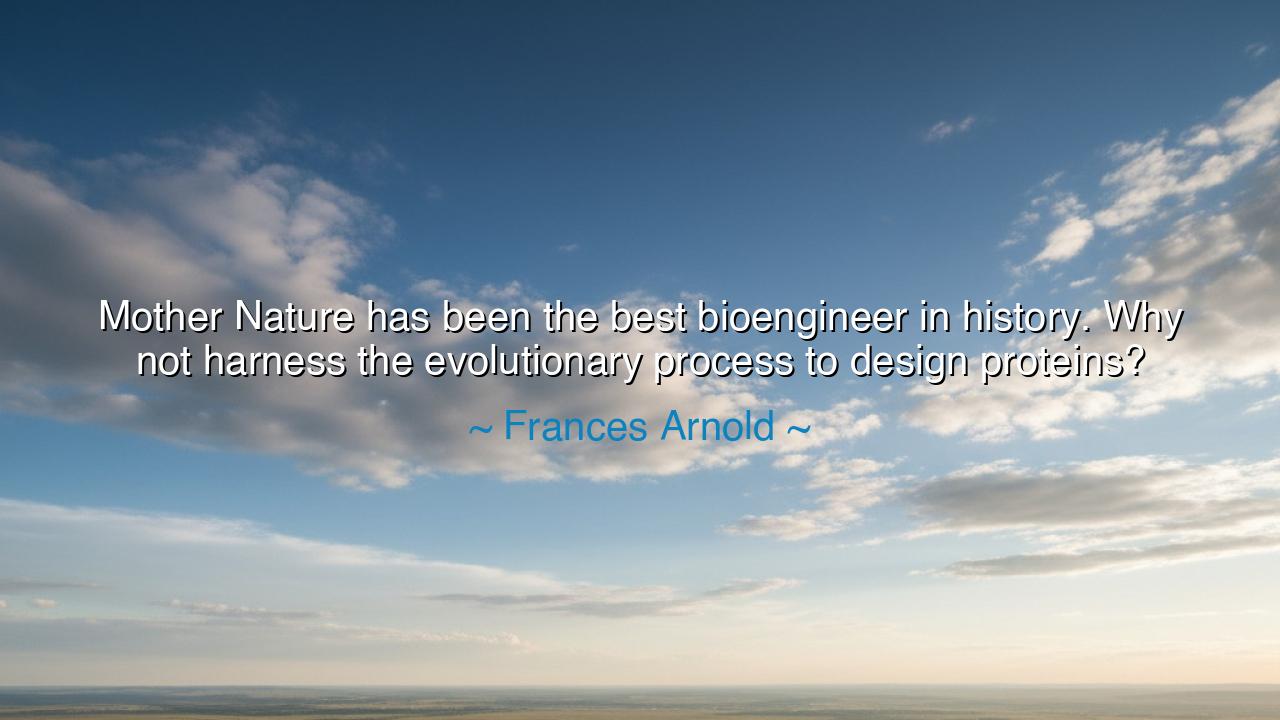
Mother Nature has been the best bioengineer in history. Why not
Mother Nature has been the best bioengineer in history. Why not harness the evolutionary process to design proteins?






“Mother Nature has been the best bioengineer in history. Why not harness the evolutionary process to design proteins?” – Frances Arnold
In this visionary statement, Frances Arnold, a pioneer of directed evolution and Nobel laureate in chemistry, speaks with both humility and awe before the ancient intelligence of Nature. Her words echo like a hymn to the creative force that has shaped life across eons — the silent, tireless engineer of existence. When she calls Mother Nature the “best bioengineer in history,” she acknowledges that every tree, every wing, every breath of life is the product of an exquisite design refined not by human intellect, but by evolution itself. And when she asks, “Why not harness the evolutionary process to design proteins?” she invites humankind to learn, not from arrogance, but from reverence — to join Nature not as conqueror, but as apprentice.
The origin of this quote springs from Arnold’s revolutionary work in the field of directed evolution, a method she developed to guide the process of natural selection in the laboratory. Where previous generations of scientists tried to impose design through rigid logic and control, Arnold looked instead to the wisdom of time itself. Nature had already written the code of life — in proteins, the tiny architects of the living world — and had tested her designs through billions of years of trial and error. Arnold’s insight was profound: if evolution could create eyes that see, wings that fly, and enzymes that sustain life, then surely it could also create solutions to the challenges of the modern world — clean energy, sustainable chemistry, and medicines beyond imagination.
By “harnessing the evolutionary process,” Arnold did not mean to imitate Nature crudely, but to collaborate with it. She introduced randomness, mutation, and selection into her experiments — letting the proteins themselves “learn” through iteration and adaptation. This was not a rejection of science, but its expansion. For too long, humankind had sought to master the natural world through domination, believing reason alone could surpass the wisdom of the earth. Arnold’s approach was an act of humility and partnership — an acknowledgment that progress must come not from defiance of Nature, but from listening to her patterns.
History offers parallels to this turning point of thought. Consider Leonardo da Vinci, who gazed upon the flight of birds not as a mystery to control, but as a lesson to be understood. His sketches of wings, tendons, and feathers were acts of reverence toward Nature’s engineering — not copies, but tributes. Centuries later, human flight would emerge not from brute force, but from learning her language. Likewise, Arnold’s work continues this sacred lineage: she listens to evolution’s whispers and translates them into technology, proving that the greatest innovations arise not from invention alone, but from co-creation with the natural world.
In her words lies a deeper philosophy about wisdom and humility. For Nature is not merely a system — she is a teacher, a master of patience, and an artist of resilience. Every species, every molecule, bears the mark of her genius. Where humankind often seeks shortcuts, Nature endures. Where we impose, she adapts. And it is precisely this adaptability — this slow, unyielding process of improvement — that Arnold sought to channel. Her method reflects the timeless truth that progress born from harmony outlasts progress born from conflict. The scientist who works with Nature’s logic, not against it, becomes part of her unfolding story.
The implications of her insight reach far beyond the laboratory. In an age when humanity’s creations often scar the earth, Arnold’s philosophy stands as a call to balance. It urges us to design technologies, cities, and systems not as impositions upon the planet, but as continuations of its rhythm. Just as she “evolves” proteins to solve environmental problems, so must we evolve our own way of living — aligning our innovation with the cycles of Nature. The lesson is simple yet profound: the future will not belong to those who conquer the earth, but to those who co-create with it.
So, dear listener, take this wisdom to heart: Nature is not our rival, but our greatest mentor. Study her patience, her adaptability, her quiet genius. Let your own creations — whether in art, science, or daily life — be guided by her principles: simplicity, resilience, and grace. Learn from her that perfection is not achieved by force, but by growth; not by command, but by cooperation. For as Frances Arnold teaches, the key to designing the future lies not in rejecting Nature’s ways, but in embracing them.
And when you next look upon the living world — the spiral of a shell, the curve of a leaf, the pulse of your own breath — remember this: you are witnessing the greatest engineer in all of history. To learn from her is not only wise; it is sacred. Harness her process, honor her design, and in doing so, help shape a world worthy of the life that created it.






AAdministratorAdministrator
Welcome, honored guests. Please leave a comment, we will respond soon